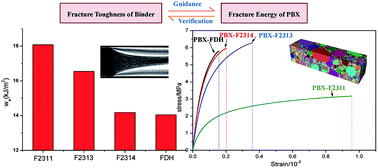Evaluation of the fracture behaviors of fluoropolymer binders with the essential work of fracture (EWF)
Abstract
The fracture behaviors of fluoropolymer binders with different molecular structures used in polymer bonded explosives (PBX) were first investigated by the essential work of fracture (EWF). The molecular motions of four selected fluoropolymers were measured by dynamic mechanical analysis (DMA). The incorporation of chlorotrifluoroethylene (CTFE), tetrafluoroethylene (TFE) and hexafluoropropylene (HFP) comonomers, would retard the molecular mobility of the fluoropolymer chain, resulting in the glass transition temperature (Tg) shifting to a higher value. Through EWF testing, the effect of the molecular structure on the fracture behaviors for fluoropolymer binders was investigated. The specific essential work of fracture, we, decreased with Tg increasing, while the specific plastic deformation work, βwp, had an opposite change trend. By fracture energy partitioning, the energy distribution during the fracture process of fluoropolymers was found. The dominant factors which affected we and βwp for the studied systems were the necking terms, as the majority of the fracture energy was dissipated in the necking and fracture process. In addition, the Brazilian test, or diametrical compression, was used to study the tensile properties of PBX. The influences of the obtained fracture parameters of polymer binders by EWF on the mechanical properties of PBX were analyzed.


 Please wait while we load your content...
Please wait while we load your content...